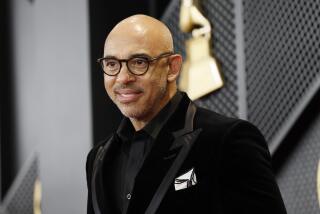WHAT LITTLE EARS YOU HAVE, GRAMMY!
Alice would have liked the Grammy Awards. They get curiouser and curiouser. They have been getting curiouser and curiouser, in fact, since the first bizarre presentations back in 1959.
Other observers, observers better qualified than this presumed elitist, can bemoan the oddities that mark the âbigâ Grammy categories--those awards that are supposed to recognize special merit in pop and rock and jazz and schlock.
The Grammys are curious enough if oneâs gaze is confined to recordings that happen to deal with unimportant things: symphonies and concertos and operas and chamber music.
The Grammys do deal in such things, you know. If you didnât know, itâs because the industry always likes to keep that fact a dim and distant secret.
Handed out--for the most part--during a much-ballyhooed CBS telecast on Feb. 25, the Grammys are supposed to cite âcreative and technical excellence.â Those, at any rate, are the nice-sounding words quoted by Michael Greene, president of the National Academy of Recording Arts and Sciences, a.k.a. NARAS.
In many ways, Grammys are like the Oscars they emulate. Grammys do not reflect profound critical judgments. They are popularity contests run for and by members of the industry. They tend to legitimize (and enlarge) commercial successes. They tend to be conservative. They pretend that music and show biz are inseparable. They celebrate glitz.
This year, prizes were awarded in 71 categories, only 12 of which surveyed what NARAS calls the âclassical field.â The winners were selected from releases that hit the stores between Oct. 1, 1984, and Sept. 30, 1985.
The selection procedure is relatively simple: The NARAS membership--which includes some 6,000 performers, composers and technicians who can boast at least six recording credits--first makes nominations, then votes en masse in the four top pop categories. Members also can vote in eight additional categories, presumably areas in which they have special expertise--or special interest.
Record companies and performing organizations sometimes wage extravagant campaigns to bring a particular product to the favorable attention of the voters. Traditionally, prizes have gone to recordings featuring the most familiar musicians performing the most familiar music. Current artistic standards were often ignored if the NARAS members could endorse a cozy household name, be it Horowitz, Price, Pavarotti, Rubinstein or Bernstein.
Occasionally, however, a dark horse has won the race. Once in a while, an obscure artist gets the nod, or, even more surprising, an esoteric piece of music rises triumphant. There can be explanations for these eccentricities, but they would seem to have little to do with a sudden rise in aesthetic perception among the rank and file.
The greatest enigma this year involved the unpredictable prominence of the Atlanta Symphony. It is a good, middle-class orchestra. Robert Shaw, its maestro, is a solid and serious musician. Telarc, the company that records the Atlantans, makes nice, clear and crisp compact discs. The Atlanta/Telarc team put together several fine recordings this year, including the Berlioz Requiem, Handelâs âMessiah,â Faureâs âPelleas et Melisandeâ and Respighiâs infernal âPines,â âBirdsâ and âFountains.â
It is all very nice. But, somehow, the Atlantans won four out of nine nominations for best classical album. At first glance, the number seems disproportionate, to be sure. At second glance, it seems ridiculous.
The Shaw performance of the Berlioz Requiem, for instance, must compete with some formidable recorded competition. The latest Schwann catalogue lists masterful performances of the same work by Leonard Bernstein with forces of the French National Radio, by Colin Davis with the London Symphony and by Lorin Maazel with the Cleveland Orchestra, not to mention the ancient and noble Charles Munch-Boston Symphony collaboration. In such company, the Shaw-Atlanta Requiem can seem little more than competent.
In any case, there were better, more important, records in 1985. Many werenât even nominated.
No matter. Shaw & Co. actually ended up winning Grammys for their Berlioz in four different categories, including best classical album.
How? No one knows for sure. Still, one can make some educated guesses.
Each member of the Atlanta Symphony is theoretically entitled to vote. A bloc of 100 well-orchestrated votes could swing a Grammy easily, under the right conditions.
âNext year,â according to the NARAS president, âweâre going to take a look at what happened here.â
Second-guessing the Grammys, category by category, is not necessarily a revealing exercise. Nevertheless, it can stimulate some provocative speculations.
Best classical album: The contending entries seemed relatively low-powered. James Levineâs recording of the Dvorak Seventh might have won simply because it utilized the vaunted Chicago Symphony, but Levine isnât Georg Solti, and the Seventh isnât the âUnfinished.â Mahlerâs Seventh with Claudio Abbado and the same orchestra might have caused a split among Chicago champions; still, it would have gotten at least one non-NARAS vote (this one). The Los Angeles Philharmonic was represented with a Gershwin set performed by the versatile Michael Tilson Thomas, but in some views the fare seems dangerously lowbrow for this category, and Tilson Thomas doesnât happen to enjoy much favor with the current Los Angeles management. Leonard Slatkin and the St. Louis Symphony won a Grammy last year for their Prokofiev Fifth; lightning was unlikely to strike again, this time with the same composerâs problematic âCinderellaâ suite.
It was nice that Mozart sonatas with Itzhak Perlman and Daniel Barenboim got a nomination, but the best-album prize usually goes to larger-scale entries. The Berlioz Requiem from Atlanta is, if nothing else, large scale.
Best classical orchestral recording: Shaw and friends won this one for their recording of Faureâs âPelleas.â (Oddly, the flip side, Berliozâs âNuits dâEte,â went unmentioned.) The also-rans in the category included the Atlanta Respighi orgy, but here the conductor was an unglamorous guest: Louis Lane. Also in contention: the same unlikely Levine and Slatkin efforts as above, plus some Liszt from Rotterdam conducted by the modestly celebrated James Conlon. Oddly, the Abbado-Mahler effort was worth a best-album nomination, but not one as best orchestral recording (shades of poor Mr. Spielberg and âThe Color Purpleâ?).
It can be no coincidence that the Berlin and Vienna Philharmonics, the Amsterdam Concertgebouw and the best of Britain received no best-orchestra nominations. American voters apparently have no vested interests in foreign orchestral institutions.
Best opera recording: A semi-surprise here. The winner was Schoenbergâs thorny âMoses und Aron.â Perhaps it got the award because the academy felt the need, somewhere, to honor the mighty Solti and his Chicago Symphony. Stravinskyâs âRakeâs Progressâ may have seemed less attractive because it came from London and was conducted by a lesser light. Wagnerâs âFliegende Hollaenderâ might have won simply because it enlisted Herbert von Karajan, but its Berlin source could have been a disadvantage. Generally routine, imported editions of âPagliacciâ and âManon Lescautâ probably lost because they caused a split in the Placido Domingo vote. Lucianissimo Pavarotti remained inexplicably uninvolved.
Best choral performance: Shaw and the Berlioz Requiem again. An antique-instrument âMessiahâ from Amsterdam hardly seemed a realistic choice, and the soupy quasi-British Requiem of Andrew Lloyd Webber doesnât happen to make many demands on the chorus. Barenboimâs Mozart Requiem seemed reasonable, but it emanated from Paris. Karajanâs Verdi seemed reasonable, but it emanated from Berlin. Where possible, NARAS supports Amerika ueber Alles .
Best instrumental solo with orchestra: A genuine upset here. Yo-Yo Maâs performance of the Elgar Cello Concerto outdistanced such popular possibilities as Andre Previn, James Galway and Perlman, not to mention such less popular possibilities as Andras Schiff and Michael Tilson Thomas.
Best instrumental solo without orchestra: And the winner was . . . Vladimir Ashkenazy, for assorted Ravel. A good choice. His competitors: Claudio Arrau (too late), Francois-Rene Duchable (who?), Tilson Thomas and Julian Bream.
Best chamber music: Yo-Yo Ma won again, this time for playing Brahms sonatas with Emanuel Ax. The competition here was both formidable and glamorous. It gives one pause.
Best classical vocal soloist: The contenders included such paragons as Elly Ameling, Frederica von Stade, Kiri Te Kanawa, Marilyn Horne and Placido Domingo. The winner was a little-known tenorino named John Aler, who happened--just happened--to sing the fleeting solos of the Berlioz Requiem with Shaw and the Atlanta Symphony.
Best new classical artist: Another oddity. The winner was the Chicago Pro Musica, which records for an obscure company called Reference. The competition included Sarah Brightman (the chirpy soprano in the Requiem of her husband, Andrew Lloyd Webber), Rosalind Plowright (the excellent British diva-to-be), Esa-Pekka Salonen (the brilliant Finnish conductor) and Brian Slawson (who?).
Best contemporary composition: The academy passed by new works of John Adams, George Perle and Robert Starer--all too intellectual, no doubt. The academy also passed by Philip Glassâ âSatyagrahaâ--fashionable but possibly too far-out. It bestowed top honors, of course, on the Lloyd Webber Requiem, which would rate high on any serious criticâs all-time five-worst list, but which has proven remarkably popular with the kids, bless their innocent souls and easily washed brains. Too bad the category wasnât called âBest Selling and Best Hyped Composition.â
Best engineered recording: The Atlanta guys again. Zzzz.
Best classical producer: Robert E. Woods of--guess where?--Atlanta.
The Grammy show on TV lasted nearly 3 1/2 hours. Less than 10 minutes, toward the end, was devoted to the âclassical field.â Most of that time was taken up by guitar ditties played by Christopher Parkening in honor of Andres Segovia who, at 93, shared special lifetime-achievement awards with Benny Goodman, the Rolling Stones and the Gershwin brothers. Strange bedfellows.
There were no actual presentations of awards to the classical-music winners. Their names were rattled off by a previous winner, clarinetist Richard Stoltzman, and that was that.
All-purpose applause. Quick. Time was running out.
In addition to the Grammys of â85, NARAS inducted five recordings made before 1958 into its Hall of Fame. The winners in this category were supposed to demonstrate âlasting, qualitative or historical significance.â
Comparing musical apples and avocados, a 96-member committee selected âA-Tisket, A-Tasketâ by Ella Fitzgerald, âBlue Suede Shoesâ by Carl Perkins, âCool Waterâ by the Sons of the Pioneers, âTea for Twoâ by Art Tatum and--oh, yes--the âGoldbergâ Variations of Bach as performed by Wanda Landowska.
All musics are created equal, but some are more equal than others. The records keep on spinning.
More to Read
The biggest entertainment stories
Get our big stories about Hollywood, film, television, music, arts, culture and more right in your inbox as soon as they publish.
You may occasionally receive promotional content from the Los Angeles Times.








